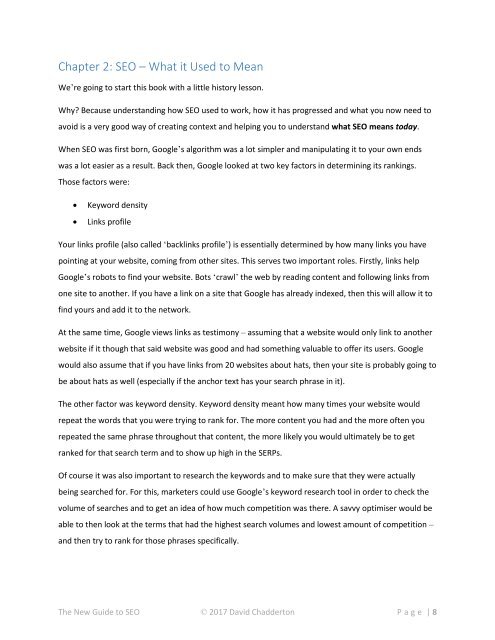The New Guide to SEO
SEO has changed. If you want to rank your website on Page 1 you need to follow certain guidelines and maybe make changes to the way you work. Find out what you need to do here ...
SEO has changed. If you want to rank your website on Page 1 you need to follow certain guidelines and maybe make changes to the way you work. Find out what you need to do here ...
You also want an ePaper? Increase the reach of your titles
YUMPU automatically turns print PDFs into web optimized ePapers that Google loves.
Chapter 2: <strong>SEO</strong> – What it Used <strong>to</strong> Mean<br />
We’re going <strong>to</strong> start this book with a little his<strong>to</strong>ry lesson.<br />
Why? Because understanding how <strong>SEO</strong> used <strong>to</strong> work, how it has progressed and what you now need <strong>to</strong><br />
avoid is a very good way of creating context and helping you <strong>to</strong> understand what <strong>SEO</strong> means <strong>to</strong>day.<br />
When <strong>SEO</strong> was first born, Google’s algorithm was a lot simpler and manipulating it <strong>to</strong> your own ends<br />
was a lot easier as a result. Back then, Google looked at two key fac<strong>to</strong>rs in determining its rankings.<br />
Those fac<strong>to</strong>rs were:<br />
• Keyword density<br />
• Links profile<br />
Your links profile (also called ‘backlinks profile’) is essentially determined by how many links you have<br />
pointing at your website, coming from other sites. This serves two important roles. Firstly, links help<br />
Google’s robots <strong>to</strong> find your website. Bots ‘crawl’ the web by reading content and following links from<br />
one site <strong>to</strong> another. If you have a link on a site that Google has already indexed, then this will allow it <strong>to</strong><br />
find yours and add it <strong>to</strong> the network.<br />
At the same time, Google views links as testimony – assuming that a website would only link <strong>to</strong> another<br />
website if it though that said website was good and had something valuable <strong>to</strong> offer its users. Google<br />
would also assume that if you have links from 20 websites about hats, then your site is probably going <strong>to</strong><br />
be about hats as well (especially if the anchor text has your search phrase in it).<br />
<strong>The</strong> other fac<strong>to</strong>r was keyword density. Keyword density meant how many times your website would<br />
repeat the words that you were trying <strong>to</strong> rank for. <strong>The</strong> more content you had and the more often you<br />
repeated the same phrase throughout that content, the more likely you would ultimately be <strong>to</strong> get<br />
ranked for that search term and <strong>to</strong> show up high in the SERPs.<br />
Of course it was also important <strong>to</strong> research the keywords and <strong>to</strong> make sure that they were actually<br />
being searched for. For this, marketers could use Google’s keyword research <strong>to</strong>ol in order <strong>to</strong> check the<br />
volume of searches and <strong>to</strong> get an idea of how much competition was there. A savvy optimiser would be<br />
able <strong>to</strong> then look at the terms that had the highest search volumes and lowest amount of competition –<br />
and then try <strong>to</strong> rank for those phrases specifically.<br />
<strong>The</strong> <strong>New</strong> <strong>Guide</strong> <strong>to</strong> <strong>SEO</strong> © 2017 David Chadder<strong>to</strong>n P a g e | 8



